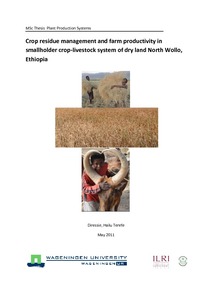Insuring against drought?related livestock mortality: Piloting index based livestock insurance in northern Kenya
Climate related shocks are among the leading cause of production and efficiency losses in smallholder crop and livestock production in rural Africa. Consequently, the identification of tools to help manage the risks associated with climactic extremities is increasingly considered to be amongst the key pillars of any agenda to enhance agricultural growth and welfare in rural Africa.
Crop residue management and farm productivity in smallholder crop-livestock system of dry land North Wollo, Ethiopia
Plano Estratégico para o Desenvolvimento do Sector Agrário (PEDSA 2011-2020)
O Desenvolvimento Agrário tem sido desde sempre uma prioridade para Moçambique. Em 1998, o Governo em colaboração com os principais parceiros desenhou o Programa de Desenvolvimento da Agricultura (PROAGRI I) com o objectivo de melhorar a coordenação das intervenções públicas na agricultura e orientar os investimentos..
The Economics of Desertification, Land Degradation, and Drought
Since the publication of the Report of the Brundtland Commission (Our Common Future) in 1987, and the consequent Earth Summit on sustainable development, global attention on natural resource scarcity and degradation has been increasing, because of climate change and rising food and energy prices.
imGoats: Goats value chains in Mozambique and India
Agricultural land management: Capturing synergies among climate change adaptation, greenhouse gas mitigation and agricultural productivity
Agricultural land management: Capturing synergies among climate change adaptation, greenhouse gas mitigation, and agricultural productivity
Quick reference: Guide on Index Based Livestock Insurance features
Training manual for pastoralists and agro-pastoralists on Index-Based Livestock Insurance
The impacts of the Arid Lands Resource Management Project (ALRMPII) on livelihoods and vulnerability in the arid and semi-arid lands of Kenya
There is an urgent need for new approaches and effective models for managing risk and promoting sustainable development in arid and semi-arid lands (ASALs), especially in the face of climate change and increasing frequency of drought in many areas.












